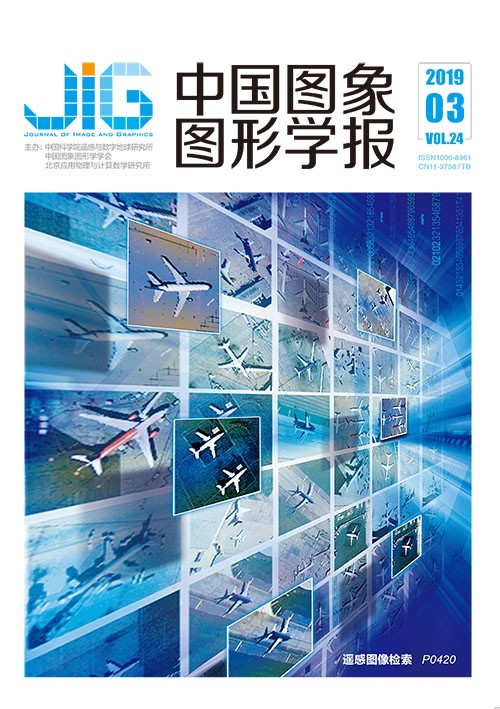
结合深度学习与相关反馈的遥感图像检索
摘 要
目的 针对基于内容的图像检索存在低层视觉特征与用户对图像理解的高层语义不一致、图像检索的精度较低以及传统的分类方法准确度低等问题,提出一种基于卷积神经网络和相关反馈支持向量机的遥感图像检索方法。方法 通过对比度受限直方图均衡化算法对遥感图像进行预处理,限制遥感图像噪声的放大,采用自学习能力良好的卷积神经网络对遥感图像进行多层神经网络的监督学习提取丰富的图像特征,并将支持向量机作为基分类器,根据测试样本数据到分类超平面的距离进行排序得到检索结果,最后采用相关反馈策略对检索结果进行重新调整。结果 在UC Merced Land-Use遥感图像数据集上进行图像检索实验,在mAP(mean average precision)精度指标上,当检索返回图像数为100时,本文方法比LSH(locality sensitive Hashing)方法提高了29.4%,比DSH(density sensitive Hashing)方法提高了37.2%,比EMR(efficient manifold ranking)方法提高了68.8%,比未添加反馈和训练集筛选的SVM(support vector machine)方法提高了3.5%,对于平均检索速度,本文方法比对比方法中mAP精度最高的方法提高了4倍,针对复杂的遥感图像数据,本文方法的检索效果较其他方法表现出色。结论 本文提出了一种以距离评价标准为核心的反馈策略,以提高检索精度,并采用多距离结合的Top-k排序方法合理筛选训练集,以提高检索速度,本文方法可以广泛应用于人脸识别和目标跟踪等领域,对提升检索性能具有重要意义。
关键词
Remote sensing image retrieval combined with deep learning and relevance feedback
Peng Yanfei, Song Xiaonan, Wu Hong, Zi Lingling(School of Electronic and Information Engineering, Liaoning Technical University, Huludao 125105, China) Abstract
Objective The traditional content-based image retrieval method can only retrieve and analyze the features of low layers, such as color, texture, and shape, which exist in an image. Therefore, a low level of visual features exist in such method, which is inconsistent with the high-level semantic meaning of the user's understanding of the image. This inconsistency results in the "semantic gap" phenomenon, which leads to the low accuracy of image retrieval. Moreover, the traditional method cannot meet the user's demand for high-accuracy retrieval, while remote sensing images have rich information, complex content, and high dimensionality. Analyzing only the low-level features greatly reduces the accuracy of image retrieval. Therefore, selecting an appropriate image feature extraction is the key step to achieving high-accuracy retrieval. At the same time, the traditional classification method is insignificantly accurate in image classification. Determining how to select a high-accuracy image classification method is also essential. A remote sensing image retrieval method based on convolutional neural network and relevance feedback support vector machine (SVM) is proposed in this research. Method The proposed method can preprocess remote sensing images by contrasting the limited histogram equalization algorithm, limiting the noise magnification of the remote sensing images, and avoiding the influence of noise interference on the retrieval precision. On the basis of the GoogLeNet convolutional neural network model with good self-learning capability, a multilayer neural network of remote sensing images is supervised and studied, the rich features of the remote sensing images are extracted, and the problem of "semantic gap" in the content-based image retrieval method is solved. The original dataset is divided into training and test sets, and selecting the training set reasonably is the basis for the best classification. If too many samples exist in other categories in the training set, then determining the hyperplane classification will be greatly affected. A multi-distance combined top-k sorting method is proposed to rationally screen the original training set. The image closest to the query one will be used as the training set. On the one hand, the method saves considerable time for subsequent determination of the optimal hyperplane. On the other hand, most dissimilar images are filtered out to avoid the influences of more dissimilar images on the classification results. The SVM is used as the basic classifier, and the optimal hyperplane is trained according to the training set samples. The retrieval results are sorted according to the distance between the test sample data and the classified hyperplane. A feedback of the distance evaluation standard is proposed to update the retrieval results with the distance evaluation standard. The strategy readjusts the experimental results. The method uses a small-sample marking method to mark the counterexample images to avoid too many markers and lose the meaning of the retrieval. In addition, the optimal hyperplane of the SVM does not need to be retrained to avoid unnecessary time waste. Only multiple iterations are used to update the retrieval results, and one feedback can achieve the desired results. Result The image retrieval experiments are performed on the remote sensing image dataset of UC Merced Land-use dataset. Experimental results show that the mean average precision (mAP) of the proposed method is increased by 29.4% compared with that of the locality-sensitive Hashing method, is 37.2% higher than that of the density-sensitive Hashing method, which is 68.8% higher than the efficient manifold ranking, and is 3.5% higher than that of the SVM method without feedback and training set screening. The number of retrieved images is 100. For the average retrieval speed, this method is four times higher than the method with the highest mAP accuracy in the comparison method. For the average recall rate and the average precision rate, this method is also higher than the comparison method, which shows that this method can improve not only the retrieval accuracy but also the retrieval speed. For complex remote sensing image data, the retrieval effect of this method is better than those of other methods. Conclusion A new feedback strategy is proposed in this study to improve the retrieval accuracy. Small-sample markers are used for the poor retrieval results and the distance evaluation standard as the core to perform many iterations. One time feedback can achieve good retrieval results. In terms of speed increase, this study proposes a multi-distance combined Top-k sorting method, which reduces the time of SVMs to train the optimal hyperplane by rationally selecting the training sample set and then improving the retrieval speed. This method can be widely applied to face recognition, target tracking, and other fields, and it is significant to improving retrieval performance.
Keywords
remote sensing image retrieval convolution neural network feedback support vector machine contrast limited adaptive histogram equalization Top-ksorting
|



 中国图象图形学报 │ 京ICP备05080539号-4 │ 本系统由
中国图象图形学报 │ 京ICP备05080539号-4 │ 本系统由